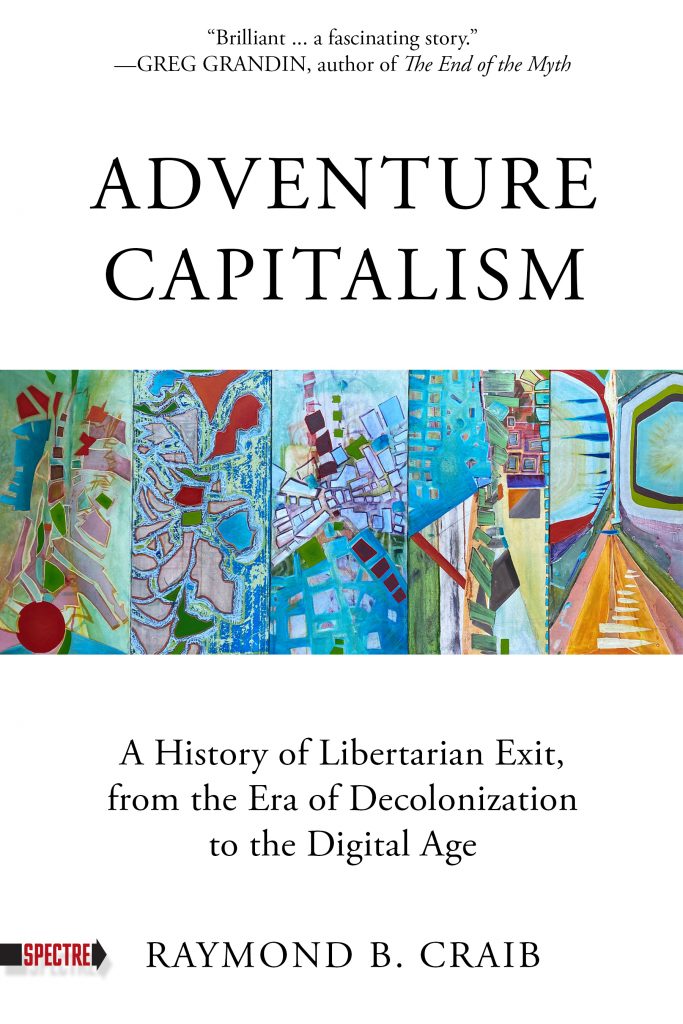By Megan Black
Diplomatic History
Within the long history of U.S. territorial ambition, a largely overlooked cadre of plotters—libertarians—dreamed of breaking new conceptual ground. Like many expansionists before them, whose antics have frequently been detailed across the pages of Diplomatic History, proponents of “libertarian exit” sought to embolden capitalist profit-seeking overseas. But unlike many before, including those businessmen associated with “Banana Republics,” libertarian expansionists explicitly aimed to obliterate U.S. state power altogether. They sought to free themselves, and empire itself, from U.S. bureaucracy. The well-heeled libertarians who imagined new sovereign utopias fit for Robinson Crusoe occupy the pages of Raymond Craib’s terrific Adventure Capitalism: from the nineteenth century’s Southern pro-slavery filibuster William Walker to the twentieth and twenty-first centuries’ millionaire and aspiring sovereign Michael Oliver; physicist and space settlement booster Gerard K. O’Neill; and Silicon Valley entrepreneur and seasteading hopeful Peter Thiel, to name a few. Convinced that unbridled liberty could only be achieved elsewhere, they set out
to solve the riddle of where precisely to exit, a unique spatial challenge in a thoroughly globalized world. Decolonizing nations, as well as the seas and the heavens, became the unlikely answers.
To cut to the chase, these libertarian bids to build a free-market Atlantis fell far short. Even so, scholars of U.S. and the world have much to glean from Adventure Capitalism. Craib deftly leverages the unrealized dreams to track key historical themes of importance to this field—illuminating key relationships between politics and economics, between decolonization and new expansionisms, with global significance. The book moves through chapters that first triangulate a libertarian intellectual worldview between the writings of Murray Rothbard, Milton Friedman, and Ayn Rand before examining actual attempts to build worlds in line with theory. One particularly important disciple was Michael Oliver, a Lithuanian Holocaust survivor and Carson City-based goldbug. Oliver’s ideology, like libertarianism more broadly, emerged in a transnational crucible, between unfathomable personal loss in concentration camps in Europe and a general distaste for the foment of Civil Rights struggles in the United States. In line with libertarian doctrine, Oliver conflated totalitarianism and social movements as equally fearsome forms of “mob rule.” Oliver’s answer to the rise of such threats in the United States was to depart from its shores, seeking a terrestrial blank slate. Yet in an increasingly sovereignty-laden world, Oliver anticipated barriers. The best bet, he concluded, would be to spin decolonization in his favor, pulling at loose threads of newly independent regions.
Oliver’s first test case, as Chapter 2 recounts, was in Tonga in 1972. There, Oliver enlisted a team of supporters to help pile sand on the reefs adjacent to Tonga and then staff his new “Republic of Minerva.” The Tongan monarch Tupuo IV, however, was unamused and swiftly sent in his own teams to build
up the reefs and assert sovereignty. After the humiliation, Oliver and Co. regrouped and tried to make inroads with other islands that form the topic of Chapters 3 and 4: first, Abaco in the Bahamas, and later, Vanuatu in the Pacific. The former attempt drew sufficient protest from white Anglo-descended settlers
to prevent any real traction while the latter attempt also failed—but only after much harm fell upon Oliver’s Indigenous collaborators, including the Melanesian politician, Jimmy Stevens. The incarceration Oliver’s supporters in Vanuatu faced calls to mind that there were material consequences to the pie-in-the-sky agendas of the ultra-wealthy. Just not for the ultra-wealthy.
Yet if the whims of libertarian elites were niche, Craib finds creative ways to situate them in a broad political and cultural milieu. Readers learn that U.S. officials and citizens rarely debated these plans, let alone sought to constrain them from afar. With the Republic of Minerva, for instance, President Richard M. Nixon took no action and may not have even registered the drama at all. Mainstream reactions were rare, but Craib gestures to relevant news coverage or popular culture to evince a broader skepticism, even opposition, to exiters’ politics—for instance, invoking the Gil Scott-Heron poem “Whitey on the Moon” (1970), which lampoons off-Earth spending in the face of gut-wrenching poverty across the color line at home (242). Readers see more tangible linkages to world leaders, including anticolonial and Indigenous leaders
such as Fidel Castro, Julius Nyerere, and Stevens. A particularly striking figure mediating between exiters and Third World leaders was Mitchell Livingston Werbell, III, a paramilitary advisor and inventor of the silencer on the M10 firearm. A right-hand man of Oliver’s, Werbell glided easily between consulting on
counterrevolution and terraforming.
Craib also succeeds in exploring deeper regional histories that often fell from elites’ view. Citing the work of New Zealand-based Samoan scholar Damon Salesa and others, Craib establishes the epistemologies and politics that had long been in place from skilled Polynesian navigators to their descendants. Across the Pacific and Oceania, the prevailing orientations to ocean places, or an “expansive Native sea,” differed radically from the cartographic imaginaries of European-descended officials and later proponents of libertarian exit (80–81). Local actors in places like Tonga resisted encroachments, helping to explain
why none of the exit strategies fully materialized. Although Craib succeeds in contextualizing libertarian elites, I wished to learn more about the everyday people enabling their reach. How did this unfolding work, and who created and sustained the sinews of power that Oliver navigated? Who labored under or paid into Oliver’s gold coin empire? Who packed the supplies, flew the planes, piloted the boats, and delivered the correspondence that helped Oliver advance from blueprint to the ground?
And how often did these infrastructures overlap with existing official circuits of U.S. power? Craib gestures to this last question and, in the process, offers fresh insight about the public-private relationships that bolstered U.S. power in the world. Libertarians, often zeroing in on the individual, had global dreams and the money to back them up. But even libertarians required that which they claimed to abhor. The state, Craib underlines, maintained property rights and ensured benefits of citizenship on which exiters relied in their globe-trotting. At the unruly edges of libertarianism, where the ideology interfaced with a wider world, its anti-statism unraveled. Escapist blueprints were thus “less an argument for no state than [they were] an argument for the privatization of the state” (243, emphasis added). If the state was not the real object of disdain, then the
true thorn was “the people,” the state’s accountability to a broader public. What proponents of libertarian exit really upheld as a core belief system was this: a contempt for democratic politics, a loathing of the masses, and a “theology of the self” (243).
Failed exit strategies also provide a new window onto how decolonization spurred new methods for controlling foreign territory. Expansionists, exiters included, did not relent even in a world awash with political sovereignties from pole to pole. Libertarian networks undertook activities that failed to conform to
the tidy borders of nation-states, from tax havens to seasteading, free private cities, and numerous off-planet ventures (topics of Chapters 5, 6, and the Epilogue). They sought advantage in gray zones of sovereignty. Tracking these gray zones may be more important than ever, particularly as the Anthropocene promises to erode terrestrial shorelines, muddy political borders, and compel new migrations. Enterprising libertarian elites, far from the front lines of climate change, have been emerging anew, working to harness the machinery of exit for various capitalist and survivalist ends. In this political and ecological climate, Craib does a great service in cautioning against the hype by distilling what has so often underpinned grand strategies of exit: a yearning for a world that disempowers the messy multitudes and empowers the select few.






